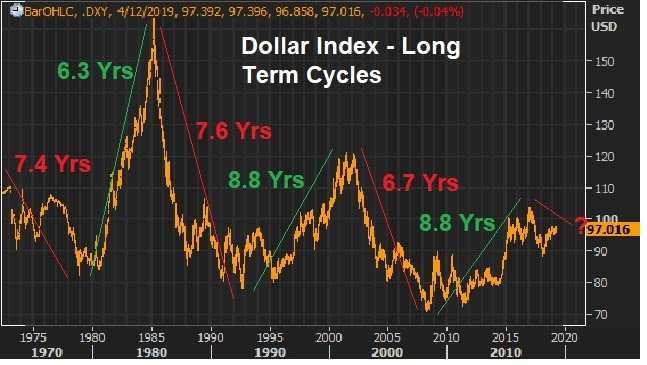April 8, 5:00 pm EST
As we discussed on Friday, the overhang of risks to markets, to the Trump administration and to the economy are as light as we’ve seen in quite some time.
With this in mind, we have a fairly light data week – which means the likelihood of a disruption in the rise in stocks and risk appetite remains low.
We get some inflation data this week, which should be tame, justifying the central bank dovishness we’ve seen in recent months. The ECB meets this week. They’ve already walked back on the idea that they might hike rates this year. Expect Draghi to hold the line on that. The Chinese negotiations have positive momentum, with reports over the weekend that talks last week advanced the ball. And we have another week before Q1 earnings season kicks in.
So, expect the upward momentum to continue for stocks. Just three months into the year and stocks are up big, and back near record highs in the U.S.. The S&P 500 is up 15% year-to-date. The DJIA is up 13%. Nasdaq is up 20%. German stocks are up 13%. Japanese stocks are up 11%. And Chinese stocks are up 32%.
Remember, we’ve talked about the signal Chinese stocks might be giving us, putting in a low on the day the Fed did it’s about face on the rate path, back on January 4th.
The aggressive bounce we’ve since had in Chinese stocks appears to be telegraphing the bottoming in the Chinese economy. That’s a big relief signal for the global economy. Commodities prices are supporting that view (sending the same signal). Oil is now up 42% on the year. And the CRB industrial metals index is up 24%.
Sign up to my Billionaire’s Portfolio and get my market beating Billionaires Portfolio … Live Portfolio Review conference calls … Weekly notes with updates and specific recommendations on following the best billionaire investors … Access to my member’s only area on the Billionaire’s Portfolio. Plus, my blog — full of information that will set you apart from other average investors.
Join now and get your risk free access by signing up here.
April 5, 5:00 pm EST
As we end the week, the overhang of risks to markets, the Trump administration and the economy are as light as we’ve seen in quite some time.
With that, stocks are back within sniffing distance of record highs. And I suspect it’s just getting started.
Remember, we’ve talked a lot about the comparisons between today and 1995. But we should also acknowledge how things played out through 2000, after the Fed backtracked on errant policy in the mid-90s.
Let’s revisit an excerpt from my daily notes on the topic …
“Last year (2018) was the first year since 1994 that cash was the best producing major asset class (among stocks, real estate, bonds, gold). The culprit for such an anomaly: An overly aggressive Fed, tightening into a low inflation, recovering economy.
The Fed ended up cutting rates by 1995, and that spurred a huge run up in stocks (up 36%). Fast forward: we now (too) have a Fed that has been overly aggressive, tightening into a low inflation, recovering economy. And just as they did in 1995, the Fed is now doing an about face. Given where the Fed has positioned itself now, compared to just three months ago, I would argue we already have a repeat of 1995 from the Fed … Within a few quarters of the 1995 rate cut, U.S. growth was printing above 4% and did so for 18 consecutive months. Stocks TRIPLED over that period.”
So, just as people are arguing that the expansion cycle of the past decade is coming to an end, we may very well see that the real boom is just getting started.
We continue to have tailwinds of fiscal policy, deregulation and structural reform still working through the economy. And the Fed has now given us the greenlight, with policies designed to fuel higher stock prices!
These are the moments when real wealth can be created in stocks. I want to make sure you are acting, not watching from the sidelines.
With that, today I want to offer you a peak at my premium advisory service for zero risk.
Sign up today and look through my entire portfolio of stocks, all of which are vetted and owned by the best billionaire investors in the world. Listen to my recorded “Live Monthly Portfolio Reviews.” Read all of my past notes to my subscribers. Take it all in. If you find that it doesn’t suit you, just email me within 30 days and I’ll refund your money in full immediately.
Frankly, I know when people join this service, they don’t leave. In fact, they refer their friends. If you can read a weekly note from me, I can help you make money.
You’ll get my market beating Billionaires Portfolio … Live Portfolio Review conference calls … Weekly notes with updates and specific recommendations on following the best billionaire investors … Access to my member’s only area on the Billionaire’s Portfolio. Plus, my blog — full of information that will set you apart from other average investors.
Join now and get your risk free access by signing up here.







